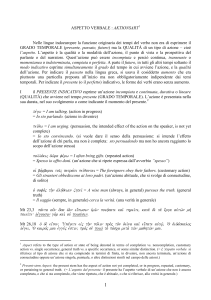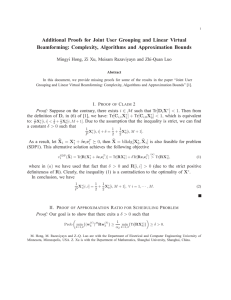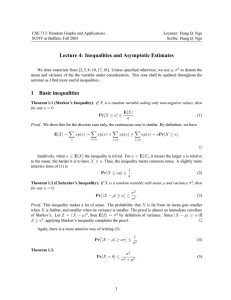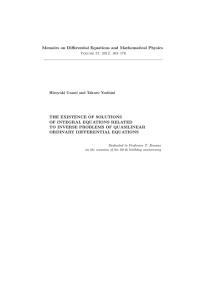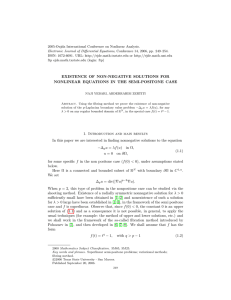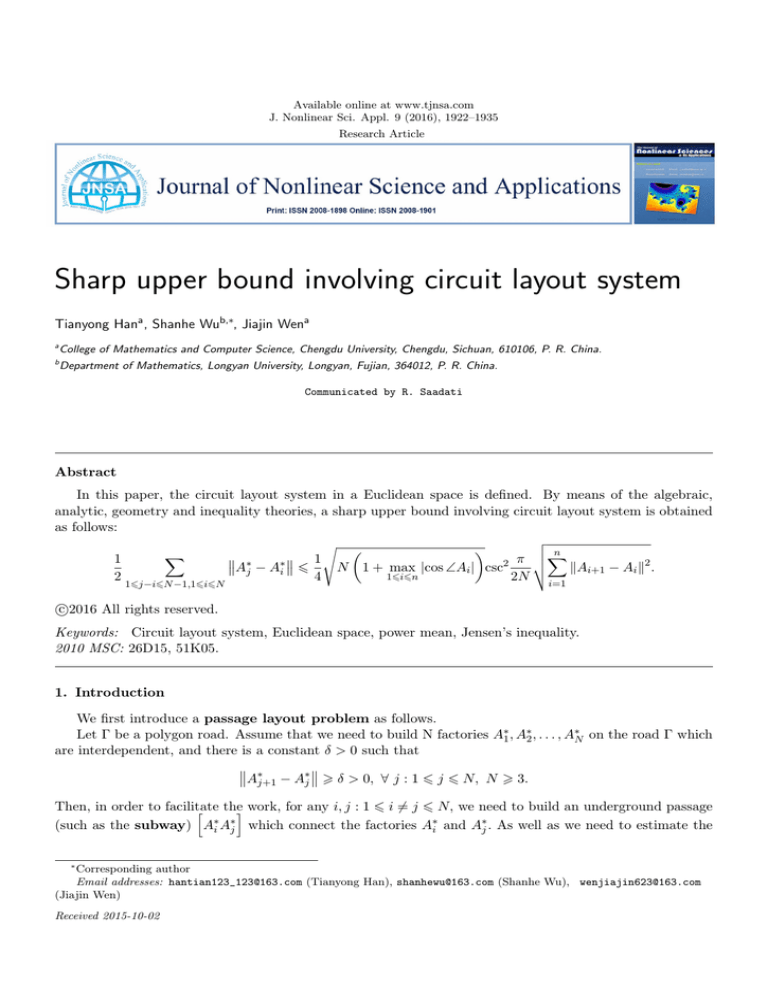
Available online at www.tjnsa.com
J. Nonlinear Sci. Appl. 9 (2016), 1922–1935
Research Article
Sharp upper bound involving circuit layout system
Tianyong Hana , Shanhe Wub,∗, Jiajin Wena
a
College of Mathematics and Computer Science, Chengdu University, Chengdu, Sichuan, 610106, P. R. China.
b
Department of Mathematics, Longyan University, Longyan, Fujian, 364012, P. R. China.
Communicated by R. Saadati
Abstract
In this paper, the circuit layout system in a Euclidean space is defined. By means of the algebraic,
analytic, geometry and inequality theories, a sharp upper bound involving circuit layout system is obtained
as follows:
v
s u n
X
uX
1
A∗j − A∗i 6 1 N 1 + max |cos ∠Ai | csc2 π t
kAi+1 − Ai k2 .
16i6n
2
4
2N
16j−i6N −1,16i6N
i=1
c
2016
All rights reserved.
Keywords: Circuit layout system, Euclidean space, power mean, Jensen’s inequality.
2010 MSC: 26D15, 51K05.
1. Introduction
We first introduce a passage layout problem as follows.
Let Γ be a polygon road. Assume that we need to build N factories A∗1 , A∗2 , . . . , A∗N on the road Γ which
are interdependent, and there is a constant δ > 0 such that
∗
Aj+1 − A∗j > δ > 0, ∀ j : 1 6 j 6 N, N > 3.
Then, in order to facilitate
h thei work, for any i, j : 1 6 i 6= j 6 N, we need to build an underground passage
(such as the subway) A∗i A∗j which connect the factories A∗i and A∗j . As well as we need to estimate the
∗
Corresponding author
Email addresses: hantian123_123@163.com (Tianyong Han), shanhewu@163.com (Shanhe Wu), wenjiajin623@163.com
(Jiajin Wen)
Received 2015-10-02
T. Han, S. Wu, J. Wen, J. Nonlinear Sci. Appl. 9 (2016), 1922–1935
1923
building cost of the underground passages. That is to say, we need to find among all possible locations of
A∗1 , A∗2 , . . . , A∗N such that the total length
1
2
X
∗
Aj − A∗i (1.1)
16j−i6N −1 , 16i6N
of the underground passages is the maximal one, where
A∗i = A∗j ⇔ i ≡ j (mod N ), i, j = 0, ±1, ±2, . . . .
(1.2)
In order to study the above problem, we need to recall some basic concepts [2, 6, 7].
Let E be a Euclidean space, and√let α, β ∈ E. The inner product of α and β is denoted by hα, βi and
the norm of α is denoted by kαk , α2 , where α2 , hα, αi . The angle between two nonzero vectors α and
β is defined to be
hα, βi
∠ (α, β) , arccos
∈ [0, π].
kαk kβk
The dimension dim E of E satisfies dim E > n if and only if there exist n linearly independent vectors
ε1 , ε2 , . . . , εn in E [6].
Let B, C ∈ E where E is a Euclidean space. Then the closed, open and closed-open segments joining
them will respectively be denoted by
[BC] , {χB,C (t)| t ∈ [0, 1]} , (BC) , {χB,C (t)| t ∈ (0, 1)} ,
[BC) , {χB,C (t)| t ∈ [0, 1)} and (BC] , {χB,C (t)| t ∈ (0, 1]} ,
where
χB,C (t) , (1 − t)B + tC.
Let A = (A1 , · · · , An ), where
Ai 6= Ai+1 , i = 1, 2, . . . , n, n > 3,
be a sequence of points in E with the dimension dim E > 2, where
Ai = Aj ⇔ i ≡ j (mod n), i, j = 0, ±1, ±2, . . . .
We say that the set
Γn (A) ,
n
[
(1.3)
[Ai Ai+1 )
i=1
is an n-polygon, or a polygon if no confusion is caused. The angle of Γn (A) at Ai , where i = 1, 2, . . . , n,
are defined as
∠Ai , ∠ (Ai − Ai−1 , Ai+1 − Ai ) .
We also denote the total length (or perimeter) of an n-polygon Γn (A) by
|Γn (A)| ,
n
X
kAi+1 − Ai k ,
i=1
and we say that
kΓn (A)k ,
1
2
X
kAj − Ai k
16j−i6n−1,16i6n
is the norm of the n-polygon Γn (A).
The circuit layout system CLS {Γn (A), ΓN (A∗ ), δ}E is defined as follows [6].
T. Han, S. Wu, J. Wen, J. Nonlinear Sci. Appl. 9 (2016), 1922–1935
1924
Definition 1.1. Let Γn (A) and ΓN (A∗ ), where N > n > 3, be two polygons in E with the dimension
dim E > 2. We say the set
CLS {Γn (A), ΓN (A∗ ), δ}E , {Γn (A), ΓN (A∗ ), δ}
is a circuit layout system (or CLS for short) if the set is non-empty and the following conditions are
satisfied:
(H1.1) ∠Ai ∈ (0, π), i = 1, 2, . . . , n.
(H1.2) A∗j ∈ Γn (A) for j ∈ {1, 2, . . . , N } and A∗1 ∈ [A1 A2 ).
(H1.3) If A∗j , A∗j+1 ∈ [Ai Ai+1 ), then A∗j+1 ∈ (A∗j Ai+1 ) for i = 1, 2, . . . , n and j = 1, 2, . . . , N.
(H1.4) If A∗j ∈ [Ai Ai+1 ) and A∗k ∈ [Ai+1 Ai+2 ) for j, k ∈ {1, 2, . . . , N } and i ∈ {1, 2, · · · , n}, then j < k.
(H1.5) For any i ∈ {1, 2, . . . , n}, there exists j ∈ {1, 2, · · · , N } such that A∗j ∈ [Ai Ai+1 ).
(H1.6) For any j ∈ {1, 2, . . . , N }, there is δ > 0 such that
∗
Aj+1 − A∗j 6 δ.
Obviously, for the circuit layout system CLS {Γn (A), ΓN (A∗ ), δ}E , we have
|ΓN (A∗ )| 6 |Γn (A)| .
(1.4)
But in [6], the authors obtained several sharp lower bounds of |ΓN (A∗ )| as follows.
Assertion 1.2. Let CLS {Γn (A), ΓN (A∗ ), δ}E be a CLS, where n is an odd number. Then we have the
following inequality:
∠A
∠A
∗
+ 1 − sin
(N − n) δ.
(1.5)
|ΓN (A )| > |Γn (A)| sin
2
2
Assertion 1.3. Let CLS {Γn (A), ΓN (A∗ ), δ}E be a CLS, where n is an even number, and let
n
X
(−1)j+1 aj > 0.
j=1
Then we have the following two assertions:
(I) If
δ (N − n) >
n
X
(−1)j+1 aj ,
j=1
then we have
∠A
[|Γn (A)| − δ (N − n)]2
|ΓN (A )| > sin2
2
∗
2
+ 4δ cos
where
2 ∠A
Pn
ω=
2
j+1
aj
j=1 (−1)
1/2
min {{ω} , 1 − {ω}}
+ δ (N − n) ,
2
+ δ (N − n)
2δ
, {ω} = ω − [ω] ∈ [0, 1) ,
and [ω] is the Gaussian function.
(II) If
δ (N − n) 6
n
X
j=1
(−1)j+1 aj ,
(1.6)
T. Han, S. Wu, J. Wen, J. Nonlinear Sci. Appl. 9 (2016), 1922–1935
1925
then we have
|ΓN (A∗ )| >
∠A
sin2
[|Γn (A)| − δ (N − n)]2
2
2 1/2
n
X
∠A
+ cos2
(−1)j+1 aj − δ (N − n)
+ δ (N − n) .
2
(1.7)
j=1
For Assertion 1.3, one of the interesting examples is as follows.
Figure 1: The graph of the CLS {Γ4 (A) , Γ5 (A∗ ) , 2}R2 .
Example 1.4. (see Example 4.3 in [6]) Consider the CLS {Γ4 (A) , Γ5 (A∗ ) , 2}R2 , see Figure 1, where Γ4 (A)
is a rectangle, and
kA2 − A1 k = kA4 − A3 k = 6, kA3 − A2 k = kA1 − A4 k = 5,
and
A∗1 ∈ [A1 A2 ) , A∗2 ∈ [A2 A3 ) , A∗3 , A∗4 ∈ [A3 A4 ) , A∗5 ∈ [A4 A1 ) .
Then we have
√
inf {|Γ5 (A∗ )|} = 10 2 + 2.
(1.8)
In this paper, we will study the sharp upper bounds of
kΓN (A∗ )k ,
1
2
X
∗
Aj − A∗i .
16j−i6N −1,16i6N
Our purpose is to estimate the building cost of the underground passages in the above passage layout
problem.
Our main result is the following Theorem 1.5.
Theorem 1.5. Let CLS {Γn (A), ΓN (A∗ ), δ}E be a CLS, and let n > 4. Then we have
v
s u n
X
uX
1
A∗j − A∗i 6 1 N 1 + max |cos ∠Ai | csc2 π t
kAi+1 − Ai k2 .
16i6n
2
4
2N
16j−i6N −1,16i6N
i=1
Equality in (1.9) holds if E = R2 , n = N = 4 and Γn (A) = ΓN (A∗ ) is a regular 4-polygon.
(1.9)
T. Han, S. Wu, J. Wen, J. Nonlinear Sci. Appl. 9 (2016), 1922–1935
1926
The connotation of Euclidean space is very rich.
Let E be an abstract n-dimensional linear space in the real number field R, and let ε1 , ε2 , . . . , εn be the
base of E, as well as let P ∈ Rn×n be a positive definite matrix. Then, for any
α = x1 ε1 + x2 ε2 + · · · + xn εn ∈ E, β = y1 ε1 + y2 ε2 + · · · + yn εn ∈ E,
we can define the inner product hα, βi as follows,
hα, βi , (x1 , x2 , . . . , xn ) P (y1 , y2 , . . . , yn )T ,
(1.10)
which satisfies the following conditions of inner product:
(i) hα, βi = hβ, αi , ∀ α, β ∈ E;
(ii) hλα, βi = λ hα, βi , ∀ α ∈ E, ∀ λ ∈ R;
(iii) hα + β, γi = hα, γi + hβ, γi , ∀ α, β, γ ∈ E;
(iv) hα, αi > 0, ∀ α ∈ E and hα, αi = 0 ⇔ α = 0.
Hence for the above inner product hα, βi, the E is a Euclidean space where dim E = n.
Let S (Rn×n ) be a set of real symmetric matrices which are defined on Rn×n . Then, for any A, B ∈
S (Rn×n ) , we can define the inner product hA, Bi as follows,
hA, Bi , tr(AB),
(1.11)
and we can easily prove that which satisfies the conditions of inner product, where tr(A) is the trace of the
matrix A. So, for the above inner product hA, Bi, the S (Rn×n ) is a Euclidean space where dim S (Rn×n ) = n2 .
Let C[a, b] be a set of continuous functions which are defined on the interval [a, b]. Then, for any
f, g ∈ C[a, b], we can define the inner product hf, gi as follows,
Z
hf, gi ,
b
f (t)g(t)dt.
(1.12)
a
Therefore, for the above inner product hf, gi, the C[a, b] is a Euclidean space where dim C[a, b] = ∞.
Based on the above analysis, we know that Theorem 1.5 is of great theoretical significance and extensive
application value.
2. Preliminaries
In order to prove Theorem 1.5, we need seven lemmas as follows.
According to the assumptions (H1.2)–(H1.5), we may easily get the following Lemmas 2.1 and 2.2.
Lemma 2.1 (see Lemma 2.4 in [6]). Let B, C ∈ E. If B 6= C and D ∈ [BC], then
kC − Bk = kC − Dk + kD − Bk .
(2.1)
Lemma 2.2 (see Lemma 2.5 in [6]). Let CLS {Γn (A), ΓN (A∗ ), δ}E be a CLS. Then for any i ∈ {1, 2, . . . , n},
there exist
σ (i) ∈ {1, 2, . . . , N } and τ (i) ∈ {0, 1, · · · , N − n}
such that
A∗σ(i)+k ∈ [Ai Ai+1 ) , k = 0, 1, . . . , τ (i) ,
and
n
X
i=1
τ (i) = N − n.
(2.2)
T. Han, S. Wu, J. Wen, J. Nonlinear Sci. Appl. 9 (2016), 1922–1935
Lemma 2.3. If N > 4, then
N
−1
X
k=1
sin
kπ
π
= cot
.
N
2N
1927
(2.3)
Proof. According to the Euler’s formula:
exp (θj) = cos θ + j sin θ,
where j2 = −1, we see that
N
−1
X
k=1
!
N
−1
N
−1
X
X
kπ
kπj
kπ
=
= Im
sin
exp
sin
N
N
N
k=0
k=0
"
#
1 − exp (πj)
2
= Im
= Im
πj
πj
−πj
πj
1 − exp N
exp 2N exp 2N − exp 2N
!
2 exp −πj
π
2N
= cot
= Im
.
π
−2j sin 2N
2N
That is to say, (2.3) holds. The proof is completed.
Lemma 2.4. For any 4-polygon Γ4 (A, B, C, D) in E, we have
kC − Ak2 + kD − Bk2 6 kC − Bk2 + kA − Dk2 + 2kB − Ak × kD − Ck.
(2.4)
Equality in (2.4) holds if and only if ∠(B − A, D − C) = π.
Proof. Set
(B − A, C − B, D − C, A − D, C − A, D − B) = (a, b, c, d, e, f ) .
Then (2.4) can be rewritten as
e2 + f 2 6 b2 + d2 + 2kak · kck.
Since
a + b = e, c + d = −e, b + c = f, d + a = −f,
we have
2ha, bi = e2 − a2 − b2 ,
2hc, di = e2 − c2 − d2 ,
2hb, ci = f 2 − b2 − c2 ,
2hd, ai = f 2 − d2 − a2 ,
a + b + c + d = 0.
Hence
0 = (a + b + c + d)2
= a2 + b2 + c2 + d2 + 2(ha, bi + hc, di + hb, ci + hd, ai) + 2(ha, ci + hb, di)
= −(a2 + b2 + c2 + d2 ) + 2(e2 + f 2 ) + 2(ha, ci + hb, di)
= −2(a2 + b2 + c2 + d2 ) + 2(e2 + f 2 ) + (a + c)2 + (b + d)2
= −2(a2 + b2 + c2 + d2 ) + 2(e2 + f 2 ) + 2(a + c)2
= −2(b2 + d2 ) + 2(e2 + f 2 ) + 4ha, ci
(2.5)
T. Han, S. Wu, J. Wen, J. Nonlinear Sci. Appl. 9 (2016), 1922–1935
1928
> −2(b2 + d2 ) + 2(e2 + f 2 ) − 4kak · kck
⇒ e2 + f 2 6 b2 + d2 + 2kak · kck.
That is to say, (2.5) holds. Equality in (2.5) holds if and only if,
−2ha, ci = 2kak · kck ⇔ ∠(B − A, D − C) , ∠(a, c) = π.
The proof is completed.
Lemma 2.5. Let ΓN (A)(N > 4) be a polygon in E, and let
N
X
kπ
1
Sk , sin
, Lk ,
kAi+k − Ai k2 , k = 1, 2, . . . , N − 1.
N
N (2Sk )2
i=1
Then we have
Lk 6
S1
Sk
2
L1 +
Sk−1 Sk+1
(Lk+1 + Lk−1 ) , k = 2, 3, . . . , N − 2,
2Sk2
(2.6)
and equalities in (2.6) hold if, and only if,
Ai−1+k − Ai
Ai+k − Ai−1
=
, i = 1, 2, . . . , N,
Sk−1
Sk+1
(2.7)
and a sufficient condition that the equalities in (2.6) hold is that E = R2 and ΓN (A) is a regular N -polygon
in R2 .
Proof. Consider the quadrilateral Γ4 (Ai−1 , Ai , Ai−1+k , Ai+k ) . From
kAi−1+k − Ai k kAi+k − Ai−1 k
−
Sk−1
Sk+1
2
> 0,
(2.8)
we obtain that
2kAi−1+k − Ai k · kAi+k − Ai−1 k 6
Sk+1
Sk−1
kAi−1+k − Ai k2 +
kAi+k − Ai−1 k2 .
Sk−1
Sk+1
(2.9)
It follows from Lemma 2.4 and (2.9) that
kAi+k − Ai k2 + kAi−1+k − Ai−1 k2
6 kAi − Ai−1 k2 + kAi+k − Ai−1+k k2 + 2kAi−1+k − Ai k · kAi+k − Ai−1 k
Sk+1
kAi−1+k − Ai k2
6 kAi − Ai−1 k2 + kAi+k − Ai−1+k k2 +
Sk−1
Sk−1
+
kAi+k − Ai−1 k2 ,
Sk+1
(2.10)
which implies that
N
X
kAi+k − Ai k2 + kAi−1+k − Ai−1 k2 6 M,
i=1
where
N X
Sk+1
Sk−1
2
2
2
2
M,
kAi − Ai−1 k + kAi+k − Ai−1+k k +
kAi−1+k − Ai k +
kAi+k − Ai−1 k .
Sk−1
Sk+1
i=1
(2.11)
T. Han, S. Wu, J. Wen, J. Nonlinear Sci. Appl. 9 (2016), 1922–1935
1929
Since
N
X
i=1
N
X
i=1
N
X
kAi+k − Ai k2 =
kAi − Ai−1 k2 =
N
X
i=1
N
X
kAi−1+k − Ai−1 k2 = 4N Sk2 Lk ,
kAi+k − Ai−1+k k2 = 4N S12 L1 ,
i=1
2
kAi−1+k − Ai k2 = 4N Sk−1
Lk−1 ,
i=1
and
N
X
2
kAi+k − Ai−1 k2 = 4N Sk+1
Lk+1 ,
i=1
the inequality (2.11) is equivalent to
8N Sk2 Lk 6 8N S12 L1 + 4N Sk+1 Sk−1 Lk−1 + 4N Sk−1 Sk+1 Lk+1 ,
that is
Lk 6
S1
Sk
2
L1 +
Sk−1 Sk+1
(Lk+1 + Lk−1 ).
2Sk2
According to Lemma 2.4, equalities in (2.6) hold if and only if (2.7) holds. Furthermore, as can be checked
easily, a sufficient condition that the equalities in (2.6) hold is that E = R2 and ΓN (A) is a regular N -polygon
in R2 . The proof is completed.
Remark 2.6. We remark here that the sufficient condition of equalities in (2.6) is not necessary. For example,
when E = R2 , N = 4, the equality in (2.6) holds if and only if Γ4 (A) is a parallelogram in R2 .
Indeed, if E = R2 , N = 4 and k = 2, then
Ai−1+k − Ai Ai+k − Ai−1
=
⇔
Sk−1
Sk+1
Ai+1 − Ai Ai+2 − Ai−1
=
⇔
S1
S3
Ai+1 − Ai =Ai+2 − Ai−1 , i = 1, 2, ⇔
(2.12)
A2 − A1 =A3 − A4 , A3 − A2 = A4 − A1 .
Remark 2.7. If ΓN (A) is a regular N -polygon, then
Lk = R02 , k = 1, 2, . . . , N − 1,
(2.13)
where R0 denotes the radius of the circumcircle of ΓN (A).
Lemma 2.8. Let ΓN (A) be a polygon in E with dim E > 2, where N > 4, and let Lk be defined in Lemma
2.5. Then for any positive integers
k, j : k > 2, k + j 6 N − 1,
there exist positive constants Ck+j,j , Ck−1,j , C1,j , which depend only on k, j, N, such that
Lk 6 Ck+j,j Lk+j + Ck−1,j Lk−1 + C1,j L1 ,
(2.14)
Ck+j,j + Ck−1,j + C1,j = 1.
(2.15)
and
A sufficient condition that equalities in (2.14) hold is that E = R2 and ΓN (A) is a regular N -polygon in R2 .
T. Han, S. Wu, J. Wen, J. Nonlinear Sci. Appl. 9 (2016), 1922–1935
1930
Proof. The proof is based on the mathematical induction method for j.
(I) When j = 1, let
2
Sk−1 Sk+1
S1
Ck+1,1 = Ck−1,1 =
> 0 and C1,1 =
> 0.
2
Sk
2Sk
From Lemma 2.5, we have
Lk 6 Ck+1,1 Lk+1 + Ck−1,1 Lk−1 + C1,1 L1 .
(2.16)
Let ΓN (A) be a regular N -polygon in R2 . In view of Remark 2.7, we know that
Lk = Lk+1 = Lk−1 = L1 = R02 > 0.
It follows from Lemma 2.5 that equality in (2.16) holds. Thus,
Ck+1,1 + Ck−1,1 + C1,1 = 1.
(II) Suppose that (2.14) and (2.15) hold for j = n > 1. Then there exist positive constants Ck+n,n ,
Ck−1,n , C1,n such that
Ck+n,n + Ck−1,n + C1,n = 1,
(2.17)
and
Lk 6 Ck+n,n Lk+n + Ck−1,n Lk−1 + C1,n L1 ,
(2.18)
and a sufficient condition that the equalities in (2.18) hold is that ΓN (A) is a regular N -polygon.
Since k + 1 > 3 > 2 and (k + 1) + n 6 N − 1, by the inductive assumption, there exist positive constants
∗ , C ∗ such that
∗
Ck+1+n,n , Ck,n
1,n
∗
∗
∗
+ C1,n
= 1,
(2.19)
+ Ck,n
Ck+1+n,n
and
∗
∗
∗
Lk + C1,n
L1 .
Lk+1+n + Ck,n
Lk+1 6 Ck+1+n,n
(2.20)
Substituting (2.20) into (2.16), we see that
∗
∗
∗
Lk + C1,n
L1 + Ck−1,1 Lk−1 + C1,1 L1 .
Lk 6 Ck+1,1 Ck+1+n,n
Lk+1+n + Ck,n
(2.21)
Note that
∗
∗
> 0.
< 1 and 1 − Ck+1,1 Ck,n
0 < Ck+1,1 < 1, 0 < Ck,n
Solving the inequality (2.21) with respect to Lk , we obtain that
∗∗
∗∗
∗∗
Lk−1 + C1,n+1
L1 ,
Lk 6 Ck+n+1,n+1
Lk+n+1 + Ck−1,n+1
where
∗∗
Ck+n+1,n+1
=
∗∗
Ck−1,n+1
=
∗∗
C1,n+1
∗
Ck+1,1 Ck+n+1,n
∗
1 − Ck+1,1 Ck,n
> 0,
Ck−1,1
∗ > 0,
1 − Ck+1,1 Ck,n
∗ +C
Ck+1,1 C1,n
1,1
=
> 0.
∗
1 − Ck+1,1 Ck,n
Let ΓN (A) be a regular N -polygon in R2 . In view of Remark 2.7, we know that
Lk = Lk+n+1 = Lk−1 = L1 = R02 > 0.
It follows from Lemma 2.5 and our induction hypothesis that the equality in (2.22) holds. Thus,
∗∗
∗∗
∗∗
Ck+n+1,n+1
+ Ck−1,n+1
+ C1,n+1
= 1.
This ends the proof.
(2.22)
T. Han, S. Wu, J. Wen, J. Nonlinear Sci. Appl. 9 (2016), 1922–1935
1931
Lemma 2.9. Let ΓN (A) be a polygon in E with dim E > 2, where N > 4, and let Lk be defined in Lemma
2.5. Then Lk 6 L1 , i.e.,
!2 N
N
X
X
sin kπ
2
N
kAi+k − Ai k 6
kAi+1 − Ai k2 , k = 2, 3, . . . , N − 2.
(2.23)
π
sin N
i=1
i=1
A sufficient condition that the equalities in (2.23) hold is that E = R2 and ΓN (A) is a regular N -polygon in
R2 .
Proof. Set k + j = N − 1 in (2.14). Then
Lk 6 CN −1,N −1−k LN −1 + Ck−1,N −1−k Lk−1 + C1,N −1−k L1 .
(2.24)
Since
Ai = Aj ⇔ i ≡ j(modN ),
we have
LN −1 ,
N
−1
N
−1
X
X
1
1
2
kA
−
A
k
=
kAi−1 − Ai k2 = L1 .
i
i+N
−1
N (2SN −1 )2
N (2S1 )2
i=1
(2.25)
i=1
It follows from (2.24) and (2.25) that, for any k ∈ {2, 3, . . . , N − 2}, there exist positive constants Ck−1 and
C1 such that
Ck−1 + C1 = 1, Lk 6 Ck−1 Lk−1 + C1 L1 ,
(2.26)
as well as
Ck−1 = Ck−1,N −1−k > 0, C1 = CN −1,N −1−k + C1,N −1−k > 0.
Repeated use (2.26), we get
∗
Lk−2 + C1∗ L1 + C1 L1
Lk 6 Ck−1 Lk−1 + C1 L1 6 Ck−1 Ck−2
∗∗∗
∗∗
Lk−3 + C1∗∗∗ L1 6 · · · 6 CL1 .
Lk−2 + C1∗∗ L1 6 Ck−3
= Ck−2
Hence,
Lk 6 CL1 .
(2.27)
Set ΓN (A) is a regular polygon in R2 , by Remark 2.7, we know that
Lk = L1 = R02 > 0.
By Lemma 2.8, equality in (2.27) holds, which implies that C = 1. Hence (2.23) holds. This completes the
proof.
3. Proof of Theorem 1.5
Proof. Set that
∗
xi , Aσ(i) − Ai ,
∗
∗
zi,k , Aσ(i)+k − Aσ(i)+k−1 ,
∗
yi , Aσ(i−1)+τ (i−1) − Ai ,
ρ , max |cos ∠Ai | .
16i6n
By Lemmas 2.1 and 2.2, we have
xi + yi+1 +
τ (i)
X
k=1
zi,k = kAi+1 − Ai k , i = 1, 2, . . . , n.
(3.1)
T. Han, S. Wu, J. Wen, J. Nonlinear Sci. Appl. 9 (2016), 1922–1935
1932
By Lemma 2.2, we obtain that
A∗ = . . . , A∗σ(i−1) , . . . , A∗σ(i−1)+τ (i−1) , A∗σ(i) , . . . , A∗σ(i)+τ (i) , . . . .
(3.2)
According to the Jensen’s inequality [7, Lemma 2.6]:
!γ
n
n
X
X
γ
xk 6
xk , ∀ x ∈ [0, ∞)n , ∀ γ ∈ (1, ∞) ,
k=1
k=1
(3.1), (3.2) and
kα−βk =
q
kαk2 + kβk2 − 2 kαk · kβk cos ∠ (α, β),
we see that
τ (i)
N
n
2 X
X
X
∗
2
2
Ai+1 − A∗i =
A∗ − A∗
zi,k
σ(i−1)+τ (i−1) +
σ(i)
i=1
i=1
k=1
τ (i)
n
2 X
X
2
zi,k
=
A∗σ(i) − Ai − A∗σ(i−1)+τ (i−1) − Aj +
i=1
=
n
X
k=1
x2i + yi2 − 2xi yi cos ∠Ai +
i=1
6
n
X
6
2
zi,k
k=1
x2i + yi2 + 2ρxi yi +
i=1
n
X
τ (i)
X
τ (i)
X
2
zi,k
k=1
2
x2i + yi2 + ρ x2i + yi +
i=1
= (1 + ρ)
x2i + yi2 +
τ (i)
n X
X
n
X
n
X
x2i
+
2
yi+1
+
= (1 + ρ)
τ (i)
n X
X
2
zi,k
i=1 k=1
(xi + yi+1 )2 +
i=1
n
X
2
zi,k
i=1 k=1
j=1
6 (1 + ρ)
2
zi,k
k=1
n
X
i=1
= (1 + ρ)
τ (i)
X
τ (i)
n X
X
2
zi,k
i=1 k=1
kAi+1 − Ai k −
i=1
τ (i)
X
2
zi,k +
τ (i)
n X
X
2
zi,k
i=1 k=1
k=1
2
τ (i)
τ (i)
n
n X
X
X
X
2
kAi+1 − Ai k −
zi,k +
zi,k
6 (1 + ρ)
i=1
= (1 + ρ)
n
X
kAi+1 − Ai k −
i=1
6 (1 + ρ)
n
X
i=1
i=1 k=1
k=1
τ (i)
X
2
zi,k +
k=1
kAi+1 − Ai k −
τ (i)
X
k=1
zi,k +
τ (i)
X
2
zi,k
k=1
τ (i)
X
k=1
2
zi,k
T. Han, S. Wu, J. Wen, J. Nonlinear Sci. Appl. 9 (2016), 1922–1935
= (1 + ρ)
n
X
1933
kAi+1 − Ai k2 ,
i=1
i.e.,
N
n
X
X
∗
Ai+1 − A∗i 2 6 (1 + ρ)
kAi+1 − Ai k2 .
i=1
(3.3)
i=1
According to the power mean inequality (see [7, Lemma 2.3] and [1, 2, 3, 4, 5]), we have that
!γ
n
n
X
X
γ
µk x k >
µk xk , ∀ x, µ ∈ [0, ∞)n , ∀ γ ∈ (1, ∞) ,
k=1
k=1
where µ satisfies the condition
n
X
µk = 1.
k=1
According to Lemmas 2.9, 2.3 and (3.1), we obtain that
1
2
X
16j−i6N −1,16i6N
N
−1 X
N
X
∗
∗
∗
Aj − A∗i = 1
A
i+k − Ai
2
k=1 i=1
=
6
6
=
6
=
=
=
N −1
N
N X 1 X
A∗ − A∗i i+k
2
N
i=1
k=1
v
u
N −1
N
X
N Xu
t1
A∗ − A∗ 2
i
i+k
2
N
i=1
k=1
v
! N
N −1 u
kπ 2 X
sin
1
N Xu
t
N
A∗ − A∗ 2
π
i+1
i
2
N sin N
i=1
k=1
!v
uN
N
−1
X
X
√
π
kπ u
1
t
A∗ − A∗ 2
N csc
sin
i+1
i
2
N
N
i=1
k=1
v
!
u
N −1
n
X
1√
π X
kπ u
t
sin
N csc
(1 + ρ)
kAi+1 − Ai k2
2
N
N
i=1
k=1
v
u n
X
π
π u
1p
t
N (1 + ρ) csc cot
kAi+1 − Ai k2
2
N
2N
i=1
v
u n
X
1p
π u
t
N (1 + ρ)csc2
kAi+1 − Ai k2
4
2N
i=1
v
s u n
uX
1
2 π t
N 1 + max |cos ∠Ai | csc
kAi+1 − Ai k2 .
16i6n
4
2N
i=1
This shows that inequality (1.9) holds.
Based on the above proof, we may see that if E = R2 , n = N = 4, Γn (A) = ΓN (A∗ ) , and Γn (A) is
a regular 4-gon, then the equality in (1.9) holds, see Example 4.1. This completes the proof of Theorem
1.5.
T. Han, S. Wu, J. Wen, J. Nonlinear Sci. Appl. 9 (2016), 1922–1935
1934
A large number of algebraic, analytic, geometry and inequality theories are used in the proof of our
results. In order to prove Theorem 1.5, we need Lemmas 2.1, 2.2, 2.3, 2.4, 2.5, 2.8 and 2.9. Indeed, the
proof of Theorem 1.5 is both interesting and difficult. Some techniques related to the proof of Theorem 1.5
can also be found in the references [1]–[3] cited in this paper.
4. An example for Theorem 1.5
We give here an example to illustrate the applications of Theorem 1.5.
Example 4.1. Consider the CLS {Γ4 (A) , Γ4 (A∗ ) , l}R2 , here E = R2 , n = N = 4, 0 < l < 1/2, and Γ4 (A)
is a regular 4-polygon where
kAi+1 − Ai k = 1, i = 1, 2, 3, 4,
see Figure 2.
Figure 2: The graph of the CLS {Γ4 (A) , Γ4 (A∗ ) , l}R2 where 0 < l < 1/2.
If Γn (A) = ΓN (A∗ ) ⇔ (A1 , A2 , A3 , A4 ) = (A∗1 , A∗2 , A∗3 , A∗4 ) , then, by (1.2), we have
1
2
X
16j−i6N −1,16i6N
∗
Aj − A∗i = 1
2
X
kAj − Ai k
16j−i63,16i64
= kA2 − A1 k + kA3 − A2 k + kA4 − A3 k
+ kA1 − A4 k + kA1 − A3 k + kA2 − A4 k
√
= 4 + 2 2,
and
v
u n
uX
1
2 π t
N 1 + max |cos ∠Ai | csc
kAi+1 − Ai k2
16i6n
4
2N
i=1
s 1
π π √
=
4 1 + max cos csc2 × 4
16i64
4
2
8
π
1
2
2
√
=
= csc2 =
π =
π
2
8
1 − cos 4
sin 8
1 − 2/2
√
= 4 + 2 2.
s
T. Han, S. Wu, J. Wen, J. Nonlinear Sci. Appl. 9 (2016), 1922–1935
1935
Therefore, equality in (1.9) holds for this case. According to Theorem 1.5, we have
√
sup {kΓ4 (A∗ )k} = 4 + 2 2.
(4.1)
On the other hand, by means of the Mathematica software, we know that
kΓ4 (A∗ )k = kA∗2 − A∗1 k + kA∗3 − A∗2 k + kA4∗ − A∗3 k + kA∗1 − A∗4 k + kA∗1 − A∗3 k + kA∗2 − A∗4 k
p
p
p
p
= (1 − x)2 + y 2 + (1 − y)2 + z 2 + (1 − z)2 + w2 + (1 − w)2 + x2
p
p
+ (1 − x − z)2 + 1 + (1 − y − w)2 + 1
√
> 2 + 2 2,
where (x, y, z, w) ∈ [0, 1]4 , and the equality holds if and only if
1
x=y=z=w= ,
2
which is the solution of the equation group
∂kΓ4 (A∗ )k
∂kΓ4 (A∗ )k
∂kΓ4 (A∗ )k
∂kΓ4 (A∗ )k
=
=
=
= 0.
∂x
∂y
∂z
∂w
Therefore,
√
inf {kΓ4 (A∗ )k} = 2 + 2 2.
(4.2)
We remark here that, for the infimum of F (x, y, z, w) , kΓ4 (A∗ )k, by Mathematica software, a direct
calculation gives
inf {F (x, y, z, w)} = F (0.49999 · · · , 0.49998 · · · , 0.50001 · · · , 0.50003 · · · ) = 4.82842712474619 · · · .
(4.3)
Acknowledgements
This work was supported by the Natural Science Foundation of China (No.61309015) and the Natural
Science Foundation of Sichuan Province Technology Department (No.2014SZ0107).
References
[1] C. B. Gao, J. J. Wen, Theory of surround system and associated inequalities, Comput. Math. Appl., 63 (2012),
1621–1640. 3
[2] J. J. Wen, T. Y. Han, S. S. Cheng, Inequalities involving Dresher variance mean, J. Inequal. Appl., 2013 (2013),
29 pages. 1, 3
[3] J. J. Wen, Y. Huang, S. S. Cheng, Theory of φ-Jensen variance and its applications in higher education, J.
Inequal. Appl., 2015 (2015), 40 pages. 3
[4] J. J. Wen, W. L. Wang, The optimization for the inequalities of power means, J. Inequal. Appl., 2006 (2006), 25
pages. 3
[5] J. J. Wen, W. L. Wang, Chebyshev type inequalities involving permanents and their applications, Linear Algebra
Appl., 422 (2007), 295–303. 3
[6] J. J. Wen, S. H. Wu, C. B. Gao, Sharp lower bounds involving circuit layout system, J. Inequal. Appl., 2013
(2013), 22 pages. 1, 1, 1, 1.4, 2.1, 2.2
[7] J. J. Wen, Z. H. Zhang, Jensen type inequalities involving homogeneous polynomials, J. Inequal. Appl., 2010
(2010), 21 pages. 1, 3, 3


